Chapter 2: Los and Enitharmon
As Urizen goes about his business, creating a dismal world and experiencing the limitations and joys of each realm, the Eternals look down from above (Plate 15, above). Here they are alarmed at what they see and are making a "Tent" (V.11.1, or Plate 10, Line 2) to separate Urizen's world off from their own. Erdman identifies the figure in the middle as Los, who will become Urizen's antagonist. The name "Los" is "Sol," the sun, spelled backwards, He is another Blake alter ego, the spirit of boundless imagination, in touch with both Eternity and suffering.
In the eternal realm, there are no limitations, and Los, or some other Eternal, knows the joy to be found in such a state (Plate 3):
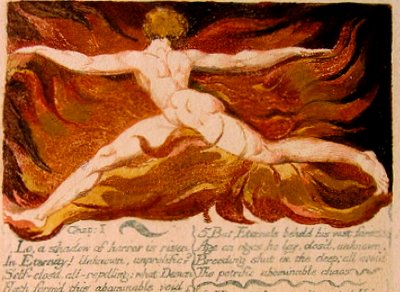
Yet Urizen must be contained, the Eternals decide. It falls Los's lot to descend below "to confine /The obscure separation alone" (III.8.2-3, or 5:39-40; Plate 6):
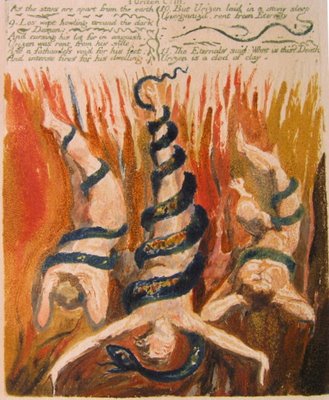
This image, I think, is related to two predecessors. Most familiarly, one thinks of Christ flanked by the two thieves at Calvary. Equally important, I think, is the famous Hellenistic sculpture of the mythical Laocoon and his two sons beset by serpents winding around them (I get this one from a website on the internet):
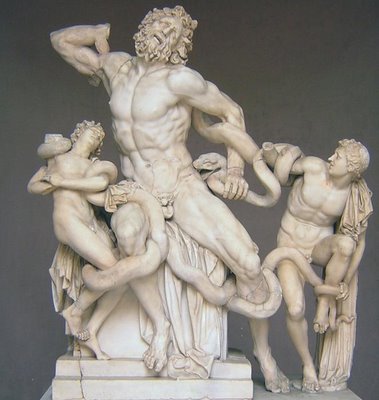
The original was in the Vatican, but the Royal Academy, where Blake studied drawing, had a clay copy
Later, in 1815, Blake made a drawing of the sculpture, which he turned into an engraving. Then he wrote some aphorisms around the sides (reproduced from Hamilyn and Phillips, William Blake (Abrams 2000):

The predicament of Laocoon and his sons was seen traditionally as a metaphor for the soul's imprisonment within a material body. A similar image comes from the very start of Blake's career, when he apprenticed in the workshop of James Basire. Blake worked on illustrations for an influential book on mythology, Jacob Bryant's A New System, or, An Analysis of Ancient Mythology, published in 1774. (This information is in the Introduction to the Garland reprint of Bryant, 1979). One of the images (Vol. II, Plate IV, opposite p. 140) is that of the Ovum Mundanum, the World Egg, with the Ophis, Greek for serpent, wrapped around it .

Again it is the soul trapped within the limitations of matter. This is what happens to Los. He becomes a part of the world he has fallen into.
An interesting development of the “Mundane Egg” is emblem 6 of Blake’s Gates of Paradise (1794).

A winged cherub steps out of an eggshell. The preceding 5 emblems in Gates of Paradise have covered the theme of the four elements, represented as different mental torments similar to the what we have seen here. Hence what the 6th one shows is the human spirit breaking free of its mental shackles. If the snake is matter, and the shell is mind, then the cherub is spirit.
I think it is significant that spirit here is a child. The release of spirit through imagination is only a beginning. Spirit in the fallen world still suffers from the limits of that world. Los, although a redeemer figure, is himself in need of redemption. Imagination must be constantly transcending itself through the clash of contraries, until it is ready to receive its own redeemer. Los and his tribulations will preoccupy Blake for the next 25 years.
In one copy of Urizen, Blake changed the figure bursting forth from Urizen, which we saw in the previous chapter as his son Fuzon, into the clean-shaven Los, flaming red. He is either falling into matter or separating from Urizen, as sky from earth, and imagination from reason (Plate 16B), even while a part of Urizen's world:

When Los sees what world he has entered into, he is "afrighted" (III.14.1, or 7:8; Plate 7):

Fallen irrevocably into matter, Los weeps. The rain, or liquid blackness, is a suitable image for the despair that grips him. The figure here is usually identified as Urizen; but Urizen is not despairing in the text here, which is about Urizen repelling "torrents" that "fall & fall" (II.4.15-16, or 4:20-21). The figure looks to me like Los (Plate 4), with his characteristic red hair:
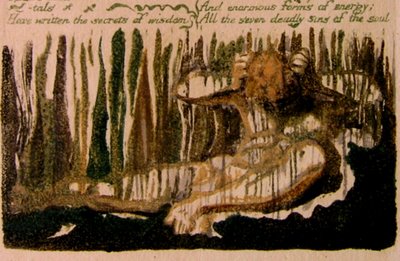
The situation here actually fits either Los or Urizen, in despair later in the narrative.
In alchemy there is a corresponding image. Rain descends upon the hermaphroditic body of the King/Queen, lying as though dead in its tomb, thus reviving its spirit (from the Philosophia Reformata, 1622:

Los, too, is at this point a unity of contrasexual opposites, although the feminine has not yet manifested.
He slowly gathers the energy he needs for his great task, and he wields his mighty hammer (Plate 18):

Los is a blacksmith, who puts things in a fire and hammers them into whatever shape is needed, rather like Blake turning flat metal into beautiful art. Los is the passionate imagination, which may save the world from dull reason's certain death.
Los makes nets and throws them, in "shudd'ring fear," around the dark changes. He binds "every change with rivets of iron & brass" (IVa.5.1-2, or 8:9-10). Then "Ages on ages roll'd over" Los, "By earthquakes riv'n, belching sullen fires." And still Los beat on his "rivets of iron" (IVb.1.1-4,8, or 10:1-4,8). Blake's etching immediately above these lines is the following (Plate 10):

According to Erdman, the figure here is Los, since Los is the one described immediately below the picture. But it seems to me it could also apply to Urizen, shut away in Los's confinement. Pictures can mean different things at once, just as words can. Blake says "May God keep us from Single Vision" (Frye, p. 420).
Los spends ages "forging chains" (IVb.2.7, or 10:17). Then:
Like the linked infernal chain,Los is binding Urizen into a body, starting with the bones (Plate 8):
A vast Spine writhed in torment
Upon the winds, shooting pain'd
Ribs like a bending cavern;
And bones of solidness froze
Over all his nerves of joy. (IVb.6.2-6, or 10:37-41)
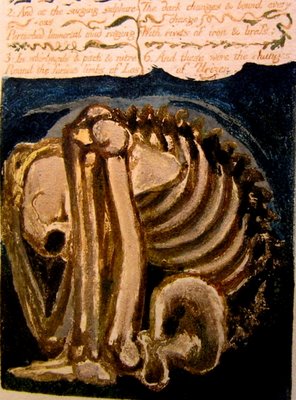
Gradually Los fashions the flesh (Plate 11):

There is a corresponding alchemical image, in the putrefactio, where a dead body is purified by fire, a process which first turns it into white bones and then resurrects it in new flesh (from the Philosophia Reformata, 1622):
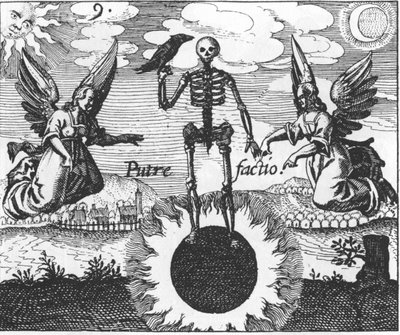
From causing such suffering, Los feels pity for Urizen. The pity comes out of him as a ball of fiery energy and blood, rather like Sophia leaving Adam in the Gnostic myths, or more familiarly Eve coming out of Adam as he sleeps (Plate 17):

So now there are two of them, Los the smith and his feminine half, Enitharmon, Pity. In Blake's etching, the woman seems to emerge from the very word "Pity" on the page (Plate 19):
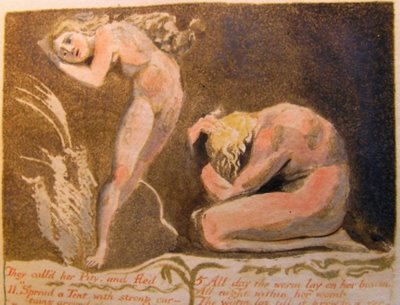
With this division of his original androgynous nature, Los's fall is complete. From the pair a child is born, whom Blake names Orc (Plate 20):

The child is his mother's joy (Plate 2; Blake put this illustration at the beginning of his book):

Orc grows quickly, and there are three to face Urizen's world (Plate 21):

The red chain here is the "Chain of Jealousy" (VII.4.4, or 20:24) formed when Orc breaks every "girdle" that Enitharmon ties around him. Fearing Orc's defiance, Los chains Orc to a rock (as Oedipus's father did to Oedipus in the Greek myth), while Enitharmon weeps.
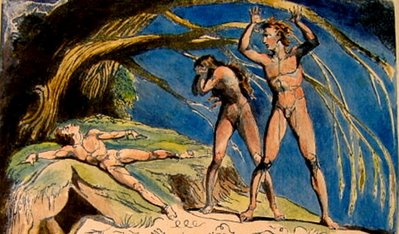
This etching is in another work, called America: a Prophecy (1793). Orc of course will get free of this chain. He is the revolutionary, who if successful only turns into what he rebelled against.. But that is a story Blake tells elsewhere.
Having chained up Orc, Los turns on Enitharmon with his jealousy, encircling her with "fires of Prophecy" (VII.9.2, or 20:43) that keep her from the sight of Orc or Urizen. If Los is an expression of Blake's own personality, as interpreters say, Blake may have been a classic jealous husband.
For his part, Urizen escapes his own chains and forms instruments with which to measure his world. Blake says, "He formed golden compasses, and began to explore the Abyss" (VII.8.4-5, or 20:39-40). Blake had already done this image, the Frontispiece to Europe: a Prophecy (1793). (I am taking this image from Hamilyn and Phillips' William Blake (Abrams, 2000).) It is perhaps Blake's single most famous etching:
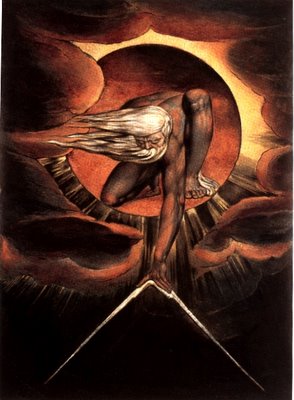
Now Urizen roams his world, carrying a "globe of fire lighting his journey" (VIII.:1.3, or 20:47-48). He sees "cruel enormities: forms of life on his forsaken mountains" (VIII.1.5-6, or 20:50-21:1; Plate 20):
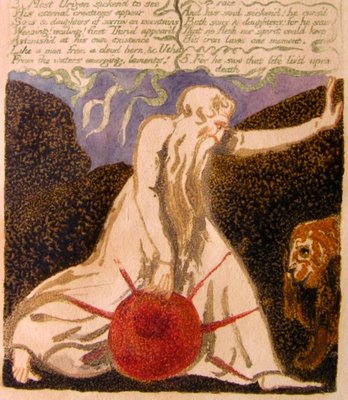
Perhaps Blake means the red globe to be the sun, and Urizen is now a sun-god. Or perhaps it is simply fire confined to serve as a lantern. The role of the lion on the right has puzzled interpreters. The lion is the animal associated with the sun, and with rulers. As Erdman observes, it is also associated with St. Jerome as the lion who befriends him after he has removed a thorn from its paw. The lion here seems to me an extension of Urizen and his red globe, a helpful force to him against the "cruel enormities." These are perhaps the shapes above Urizen, coming off the text.
There is an alchemical engraving that corresponds closely to Blake's picture, (from the Museum Hermetica of 1678):
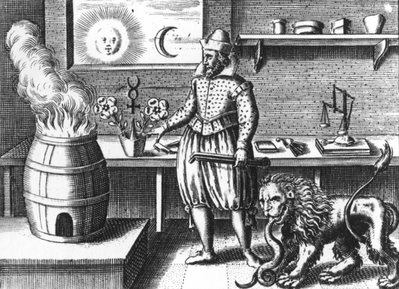
Here the barrel of fire corresponds to Urizen's spiked globe. The lion eating a serpent, I think, corresponds to Urizen's lion, helping him against the "enormities."
Urizen bears his four sons, which we saw previously. His daughters, on the other hand, come "from green herbs & cattle/ From monsters & worms of the pits" (VIII.3.14-15, or 21:20-21; Plate 25)
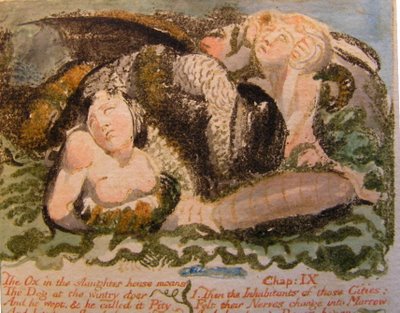
It seems to me that the serpent coils here represent matter and the chaos in which the daughters emerge.
Urizen is dismayed at his unworshipful descendants. He gave them laws, but none can keep them.. He wanders woefully over their cities. As he goes,
A cold shadow follow'd himBlake pictures this shadow as the folds of Urizen's robe flowing behind him (Plate 27):
Like a spiders web, moist, cold & dim
drawing out from his sorrowing soul...(VIII.6.5-7, or 25:9-11)
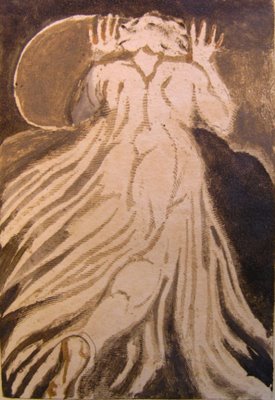
It is not clear what Urizen is doing with his hands. Erdman suggests that he is going through circular spaces and fending off shadows. Perhaps he is making his way through clouds or dense fog. Or he is pushing something before him, such as the globe he was carrying, the sun, or the earth. Blake says this web is "a Female in embryo" (VIII.7.4, or 25:18). I think he has in mind Vala, whom we will meet in Jerusalem.
The membrane becomes a net binding him. He is caught in a "Net of Religion" (VIII.9.1, or 25:22) of his own making (Plate 28):

The Genesis of Blake's world is complete.

0 Comments:
Post a Comment
<< Home